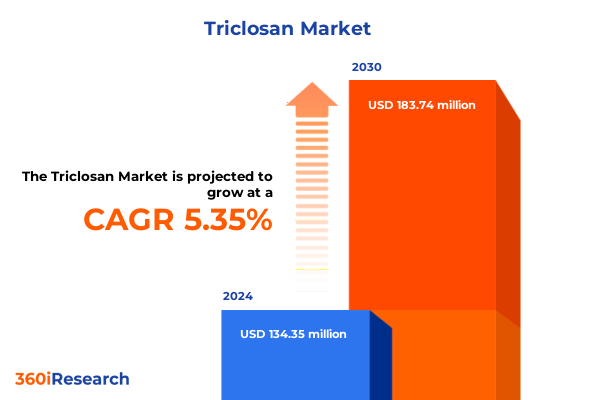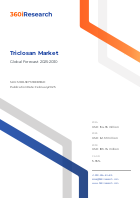The Triclosan Market size was estimated at USD 134.35 million in 2024 and expected to reach USD 141.31 million in 2025, at a CAGR 5.35% to reach USD 183.74 million by 2030.

Executive Summary Introduction
Introduction
Triclosan has emerged as a pivotal antimicrobial ingredient, infiltrating diverse products from personal care formulations to industrial disinfectants. As regulatory scrutiny intensifies and consumer demand for safer, more sustainable solutions grows, stakeholders across the supply chain are reassessing strategies and investments. This executive summary delivers a concise yet comprehensive overview of the triclosan market, spotlighting the drivers reshaping its trajectory and equipping decision-makers with the insights needed to navigate an evolving landscape. Building on rigorous primary and secondary research, this analysis highlights transformative shifts, the impact of new tariff measures, segmentation dynamics, regional performance, leading participants, and targeted recommendations to unlock growth opportunities while mitigating risks. Whether you represent a multinational chemical provider, a product manufacturer, or an end-user seeking reliable antimicrobial efficacy, this report equips you to make data-driven decisions in a market defined by both innovation and regulation.
Key Market Dynamics and Shifts
Transformative Shifts in the Landscape
Over the past five years, triclosan has transitioned from a mainstream antimicrobial additive to a catalyst for innovation as manufacturers respond to tightening regulations and shifting consumer expectations. Regulatory bodies in North America and Europe have imposed stringent usage limits and labeling requirements, compelling formulators to explore alternative biocides or to optimize triclosan concentrations for maximum efficacy with minimal environmental impact. Simultaneously, the rise of sustainability as a corporate imperative has driven investments in greener manufacturing processes, waste reduction, and closed-loop recycling. On the demand side, heightened awareness of hygiene-exacerbated by global health crises-has elevated the role of triclosan in applications such as medical devices and healthcare textiles. Digital platforms have also influenced purchasing behavior, accelerating the shift toward online channels that offer greater product transparency and rapid delivery. Collectively, these forces are reshaping supply chains, R&D priorities, and competitive dynamics, creating fertile ground for both established players and agile newcomers prepared to innovate.
Looking ahead, the market will continue to be defined by three overarching trends: regulatory harmonization across jurisdictions; proliferation of alternative antimicrobials; and integration of advanced analytics to optimize dosing and performance. Companies that proactively align with evolving mandates, invest in next-generation solutions, and leverage data-driven capabilities will secure a competitive edge.
Impact of 2025 U.S. Tariffs
Cumulative Impact of United States Tariffs 2025
In January 2025, the United States implemented a new schedule of tariffs on imported chemical intermediates, including key raw materials used in triclosan production. These duties, ranging from 5% to 25% depending on origin and HS code classification, have reverberated across the value chain. Domestic manufacturers sourcing intermediate compounds from Asia-Pacific regions face increased input costs, prompting strategic shifts toward near-shoring and expanded local production capacity. Simultaneously, some suppliers have renegotiated long-term contracts to lock in favorable terms, while others have explored vertical integration to mitigate tariff exposure.
Downstream, formulators of personal care products and industrial cleaners are confronting margin compression or potential price hikes. To remain competitive, many are optimizing formulations to reduce triclosan loadings without compromising antimicrobial efficacy, leveraging advanced process technologies that enhance yield. In parallel, distributors have diversified their product portfolios to include tariff-exempt or lower-duty alternatives, balancing risk across multiple biocidal chemistries. As these adaptations take hold, the market is tilting toward suppliers with robust global footprints, integrated logistics capabilities, and deep expertise in tariff classification and compliance. Ultimately, the 2025 tariff regime will act as a catalyst for supply chain resilience and innovation, rewarding organizations that demonstrate strategic agility.
Segmentation Performance Highlights
Key Segmentation Insights
Based on Type, the market is studied across industrial grade and pharmaceutical grade, revealing that industrial-grade triclosan maintains a higher consumption volume due to its adoption in large-scale cleaning and disinfecting operations, whereas pharmaceutical grade yields premium margins in medical and personal care applications. Based on Functionality, the market is studied across antiseptic, disinfectant, and preservative functions; antiseptic formulations dominate personal care products, disinfectant blends drive growth in healthcare textiles and medical devices, and preservative concentrates anchor cosmetic and detergent stability. Based on Application, the market is studied across cosmetic products, detergents & cleaners, medical products, personal care products, and textiles & plastics, with the detergents & cleaners segment experiencing the fastest uptake owing to heightened hygiene protocols in industrial and institutional settings. Based on End-User Industry, the market is studied across the consumer goods industry, healthcare industry, and industrial sector; the healthcare segment commands premium pricing and stringent quality standards, while the consumer goods industry relies on large-volume contracts for items like soaps and oral care products. Based on Sales Channel, the market is studied across offline channels and online channels, and offline distribution remains the predominant route for bulk sales, whereas e-commerce platforms are rapidly gaining traction for specialized formulations and smaller batch orders.
These segmentation dynamics underscore the importance of tailored product development, targeted marketing, and agile logistics. Companies that align their portfolios with high-growth segments-such as disinfectant grade in healthcare and online specialty sales-can capture outsized returns while leveraging operational efficiencies in bulk supply.
This comprehensive research report categorizes the Triclosan market into clearly defined segments, providing a detailed analysis of emerging trends and precise revenue forecasts to support strategic decision-making.
- Type
- Functionality
- Application
- End-User Industry
- Sales Channel
Regional Market Landscape
Key Regional Insights
In the Americas, robust demand for household disinfectants and oral care products continues to drive triclosan consumption, supported by established chemical infrastructure and a mature regulatory framework. Local producers benefit from direct access to raw materials and streamlined distribution networks, fostering competitive pricing and incremental capacity expansions. In Europe, Middle East & Africa, stringent EU regulations have spurred innovation in eco-friendly formulations and prompted selective market withdrawals or reformulations. Meanwhile, Middle Eastern nations are investing in downstream chemical parks to diversify their industrial bases, creating new hubs for antimicrobial production. In Asia-Pacific, rapid urbanization and rising disposable incomes fuel growth in personal care and textile applications, with players in China, India, and Japan ramping up production to meet escalating regional demand. However, navigating varying regulatory regimes-from India’s state-level notifications to China’s centralized approval process-remains a key challenge.
Regional investment trends illustrate a clear bifurcation: North American and Western European markets prioritize regulatory compliance and sustainability, while Asia-Pacific markets emphasize capacity expansion and cost optimization. Companies that tailor their strategies to regional nuances-such as leveraging free trade agreements in the Americas, aligning with EU REACH mandates, or forming joint ventures in Asia-Pacific-stand to capture the most significant growth opportunities.
This comprehensive research report examines key regions that drive the evolution of the Triclosan market, offering deep insights into regional trends, growth factors, and industry developments that are influencing market performance.
- Americas
- Asia-Pacific
- Europe, Middle East & Africa
Competitive Landscape Overview
Key Companies Insights
Leading participants such as BASF SE and Cayman Chemical leverage global R&D networks and expansive production footprints to optimize triclosan manufacturing and formulation. These incumbents capitalize on economies of scale and robust distribution channels to meet diverse end-user demands. Colgate-Palmolive Company integrates triclosan into oral care and personal hygiene brands, leveraging brand equity and global marketing reach to sustain premium pricing. Meanwhile, specialized producers like Dev IMPEX and Fengchen Group Co., Ltd. focus on contract manufacturing services, offering customized purity levels and flexible batch sizes to accommodate pharmaceutical and cosmetic clients.
On the innovation front, Jiangsu Huanxin High-tech Materials Co., Ltd. and Vivimed Labs Ltd. invest heavily in green synthesis pathways and continuous flow processes to reduce waste and energy consumption. Kumar Organic Products Limited and Salicylates and Chemicals Pvt. Ltd. differentiate through backward integration of key intermediates, securing stable supply and cost advantages. Shandong Aoyou Biological Technology exploits niche applications in medical textiles and advanced wound-care products, demonstrating the potential for triclosan to evolve beyond conventional disinfection. Collectively, these companies exemplify the industry’s pivot toward sustainability, process innovation, and customer-centric service models.
This comprehensive research report delivers an in-depth overview of the principal market players in the Triclosan market, evaluating their market share, strategic initiatives, and competitive positioning to illuminate the factors shaping the competitive landscape.
- BASF SE
- Cayman Chemical
- Colgate-Palmolive Company
- Dev IMPEX
- Fengchen Group Co.,Ltd
- Jiangsu Huanxin High-tech Materials Co., Ltd.
- Kumar Organic Products Limited
- Salicylates and Chemicals Pvt. Ltd.
- Shandong Aoyou Biological Technology
- Vivimed Labs Ltd.
Strategic Recommendations
Actionable Recommendations for Industry Leaders
- Proactively align R&D roadmaps with emerging regulations by investing in next-generation antimicrobial alternatives and green chemistry platforms, ensuring a smooth transition as triclosan usage thresholds tighten.
- Enhance supply chain resilience through strategic near-shoring, multi-sourcing agreements, and tariff optimization strategies to mitigate the impact of evolving trade policies and logistics disruptions.
- Expand digital capabilities by deploying advanced analytics to optimize formulation efficacy, reduce waste, and forecast demand at SKU level, fostering a data-driven approach to product development and inventory management.
- Cultivate strong partnerships with end-users and regulatory bodies through collaborative pilot programs, joint technical roadshows, and transparent safety data sharing, building trust and accelerating market access.
- Diversify distribution models by balancing bulk sales via traditional offline channels with targeted direct-to-consumer offerings through online platforms, capturing high-margin niche segments while preserving scale economies.
- Drive sustainability credentials by obtaining recognized eco-certifications, publishing life-cycle assessments, and piloting circular approaches to raw-material sourcing and waste valorization, meeting the elevated ESG expectations of investors and consumers.
Explore AI-driven insights for the Triclosan market with ResearchAI on our online platform, providing deeper, data-backed market analysis.
Ask ResearchAI anything
World's First Innovative Al for Market Research
Executive Summary Conclusion
Conclusion
The triclosan market stands at a crossroads, influenced by regulatory realignments, tariff evolutions, and shifting consumer preferences. While traditional volume-driven strategies will remain relevant, the path forward favors companies that embrace agility, sustainability, and data-driven innovation. By understanding the nuanced segmentation dynamics, regional variations, and competitive imperatives outlined in this summary, stakeholders can craft targeted strategies to safeguard margins, unlock new revenue streams, and maintain regulatory compliance. As the industry continues to evolve, those who proactively adapt will not only withstand emerging challenges but also capitalize on emerging growth pockets within personal care, healthcare, and industrial applications.
This section provides a structured overview of the report, outlining key chapters and topics covered for easy reference in our Triclosan market comprehensive research report.
- Preface
- Research Methodology
- Executive Summary
- Market Overview
- Market Dynamics
- Market Insights
- Cumulative Impact of United States Tariffs 2025
- Triclosan Market, by Type
- Triclosan Market, by Functionality
- Triclosan Market, by Application
- Triclosan Market, by End-User Industry
- Triclosan Market, by Sales Channel
- Americas Triclosan Market
- Asia-Pacific Triclosan Market
- Europe, Middle East & Africa Triclosan Market
- Competitive Landscape
- ResearchAI
- ResearchStatistics
- ResearchContacts
- ResearchArticles
- Appendix
- List of Figures [Total: 26]
- List of Tables [Total: 236 ]
Get the Full Report
Call-To-Action
Unlock deeper insights and gain a competitive edge by accessing the full market research report. To explore comprehensive data, detailed analysis, and bespoke advisory services, contact Ketan Rohom, Associate Director, Sales & Marketing, and secure your copy today.

- How big is the Triclosan Market?
- What is the Triclosan Market growth?
- When do I get the report?
- In what format does this report get delivered to me?
- How long has 360iResearch been around?
- What if I have a question about your reports?
- Can I share this report with my team?
- Can I use your research in my presentation?




